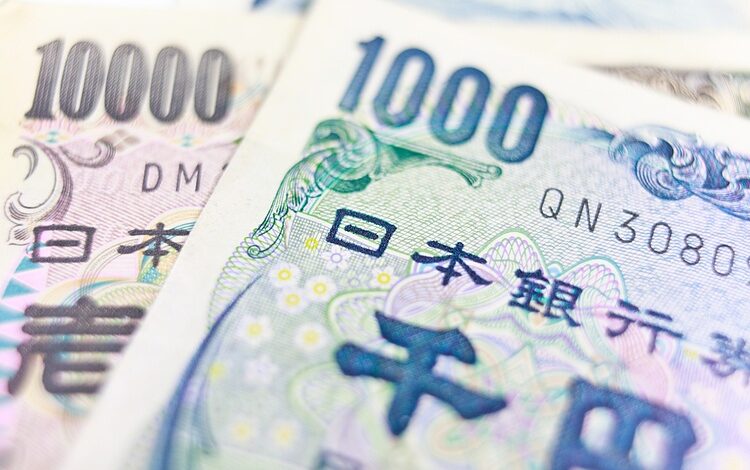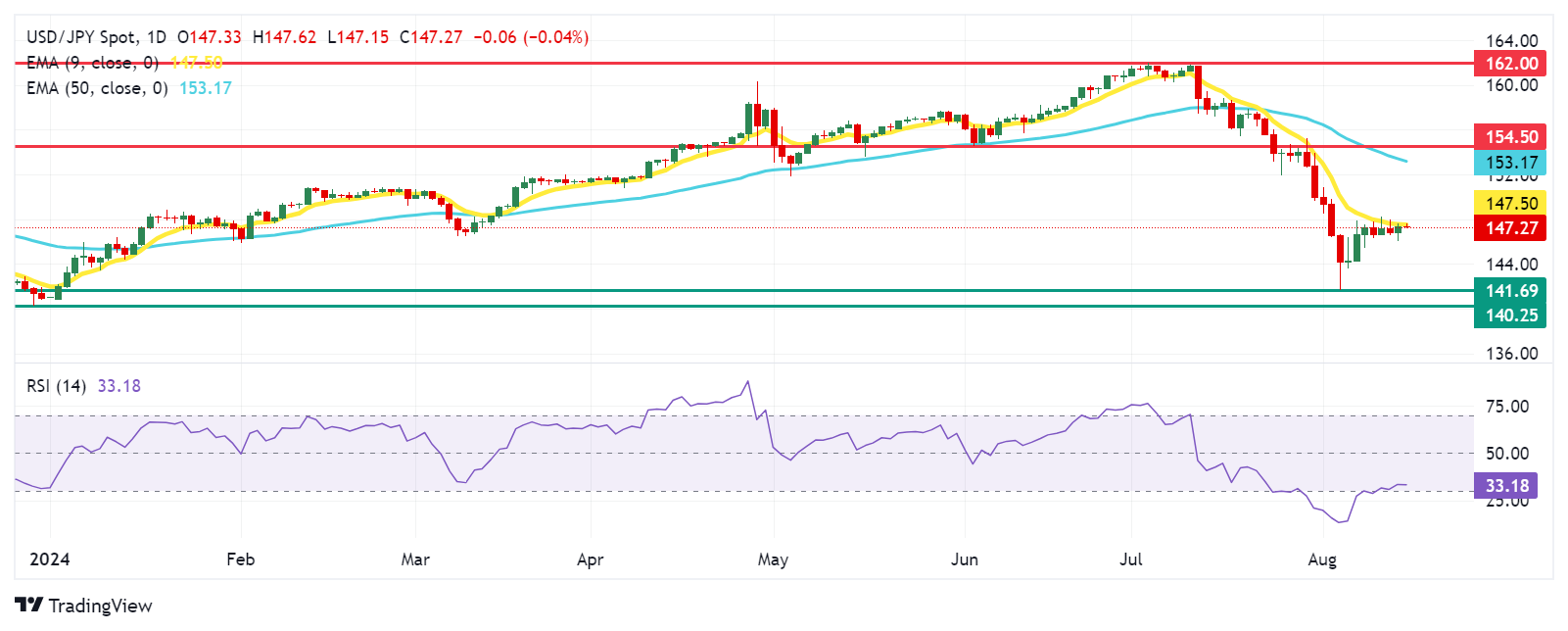Japanese Yen remains stronger as US Dollar remains tepid ahead of key economic data

- The Japanese Yen edges higher due to rising odds of the BoJ adopting a hawkish stance amid upbeat GDP data.
- Japan’s Gross Domestic Product increased by 0.8% in Q2, marking the strongest quarterly growth since Q1 of 2023.
- The US Dollar advanced due to improved Treasury yields despite a dovish sentiment surrounding the Fed.
The Japanese Yen (JPY) gains ground against the US Dollar (USD) on Thursday. This upside occurred as Japan’s Gross Domestic Product (GDP) growth for the second quarter surpassed expectations, supporting the argument for a potential near-term interest rate hike by the Bank of Japan (BoJ).
Japanese Economy Minister Yoshitaka Shindo stated that the economy is anticipated to recover gradually as wages and income improve. Shindo also added that the government will collaborate closely with the Bank of Japan to implement flexible macroeconomic policies.
However, the USD/JPY pair received support from the improved US Dollar amid higher Treasury yields. However, the potential for further gains in the Greenback may be constrained by increasing expectations of at least a 25 basis point rate cut by the US Federal Reserve (Fed) in September.
The moderate US Consumer Price Index (CPI) data has sparked debate about the extent of the Fed’s potential rate cut in September. Traders are favoring a more modest 25 basis point reduction, with a 60% probability, while a 50 basis point cut is still on the table. According to CME FedWatch, there is a 36% chance of the larger cut occurring in September.
Daily Digest Market Movers: Japanese Yen declines despite upbeat GDP data
- Japan’s Gross Domestic Product (GDP) grew by 0.8% quarter-on-quarter in Q2, surpassing market forecasts of 0.5% and rebounding from a 0.6% decline in Q1. This marked the strongest quarterly growth since Q1 of 2023. Meanwhile, the annualized GDP growth reached 3.1%, exceeding the market consensus of 2.1% and reversing a 2.3% contraction in Q1. This was the strongest yearly expansion since Q2 of 2023.
- Federal Reserve Bank of Chicago President Austan Goolsbee expressed growing concern on Wednesday about the labor market rather than inflation, noting recent improvements in price pressures alongside weak jobs data. Goolsbee added that the extent of rate cuts will be determined by the prevailing economic conditions, per Bloomberg.
- US headline Consumer Price Index (CPI) rose 2.9% year-over-year in July, slightly down from the 3% increase in June and below market expectations. The Core CPI, which excludes food and energy, climbed 3.2% year-over-year, a slight decrease from the 3.3% rise in June but aligned with market forecasts.
- Japanese Prime Minister Fumio Kishida announced at a press conference on Wednesday that he will not seek re-election as the leader of the Liberal Democratic Party (LDP) in September. Kishida emphasized the need to combat Japan’s deflation-prone economy by promoting wage and investment growth and achieving the goal of expanding Japan’s GDP to ¥600 trillion.
- Rabobank’s senior FX strategist, Jane Foley, observes that this week’s series of US data releases, along with next week’s Jackson Hole event, should provide the market with clearer insights into the potential responses of US policymakers. However, their main expectation is that the Fed will reduce rates by 25 basis points in September and likely cut them again before the end of the year.
- On Tuesday, Atlanta Fed President Raphael Bostic stated that recent economic data has increased his confidence that the Fed can achieve its 2% inflation target. However, Bostic indicated that additional evidence is required before he would support a reduction in interest rates, according to Reuters.
- Japan’s parliament is scheduled to hold a special session on August 23 to discuss the Bank of Japan’s (BoJ) decision to raise interest rates last month. BoJ Governor Kazuo Ueda is expected to attend the session, according to government sources cited by Reuters.
- The Bank of Japan’s Summary of Opinions from the Monetary Policy Meeting on July 30 and 31 indicated that several members believe economic activity and prices are evolving as expected by the BoJ. They are aiming for a neutral rate of “at least around 1%” as a medium-term target.
Technical Analysis: USD/JPY holds ground near 147.50 with testing the nine-day EMA barrier
USD/JPY trades around 147.40 on Thursday. The daily chart analysis shows that the pair is positioned slightly below the nine-day Exponential Moving Average (EMA), suggesting a short-term bearish trend. Additionally, the 14-day Relative Strength Index (RSI) is positioned slightly above the 30 level, suggesting a potential for a correction.
In terms of support levels, the USD/JPY pair may navigate the region around a seven-month low of 141.69, reached on August 5. Further downside could see the pair approaching a secondary support level at 140.25.
On the upside, the USD/JPY pair may encounter immediate resistance at the nine-day Exponential Moving Average (EMA) around the 147.53 level, followed by the 50-day EMA at 153.40 level, with the potential to test the resistance level at 154.50, where previous support has now turned into resistance.
USD/JPY: Daily Chart
Japanese Yen PRICE Today
The table below shows the percentage change of Japanese Yen (JPY) against listed major currencies today. Japanese Yen was the strongest against the Swiss Franc.
| USD | EUR | GBP | JPY | CAD | AUD | NZD | CHF | |
|---|---|---|---|---|---|---|---|---|
| USD | 0.01% | -0.21% | -0.09% | -0.06% | -0.29% | -0.01% | -0.05% | |
| EUR | -0.01% | -0.23% | -0.13% | -0.07% | -0.39% | -0.17% | -0.06% | |
| GBP | 0.21% | 0.23% | 0.11% | 0.16% | -0.16% | 0.07% | 0.26% | |
| JPY | 0.09% | 0.13% | -0.11% | 0.02% | -0.22% | -0.03% | 0.14% | |
| CAD | 0.06% | 0.07% | -0.16% | -0.02% | -0.24% | -0.09% | 0.10% | |
| AUD | 0.29% | 0.39% | 0.16% | 0.22% | 0.24% | 0.22% | 0.41% | |
| NZD | 0.00% | 0.17% | -0.07% | 0.03% | 0.09% | -0.22% | 0.19% | |
| CHF | 0.05% | 0.06% | -0.26% | -0.14% | -0.10% | -0.41% | -0.19% |
The heat map shows percentage changes of major currencies against each other. The base currency is picked from the left column, while the quote currency is picked from the top row. For example, if you pick the Japanese Yen from the left column and move along the horizontal line to the US Dollar, the percentage change displayed in the box will represent JPY (base)/USD (quote).
Japanese Yen FAQs
The Japanese Yen (JPY) is one of the world’s most traded currencies. Its value is broadly determined by the performance of the Japanese economy, but more specifically by the Bank of Japan’s policy, the differential between Japanese and US bond yields, or risk sentiment among traders, among other factors.
One of the Bank of Japan’s mandates is currency control, so its moves are key for the Yen. The BoJ has directly intervened in currency markets sometimes, generally to lower the value of the Yen, although it refrains from doing it often due to political concerns of its main trading partners. The current BoJ ultra-loose monetary policy, based on massive stimulus to the economy, has caused the Yen to depreciate against its main currency peers. This process has exacerbated more recently due to an increasing policy divergence between the Bank of Japan and other main central banks, which have opted to increase interest rates sharply to fight decades-high levels of inflation.
The BoJ’s stance of sticking to ultra-loose monetary policy has led to a widening policy divergence with other central banks, particularly with the US Federal Reserve. This supports a widening of the differential between the 10-year US and Japanese bonds, which favors the US Dollar against the Japanese Yen.
The Japanese Yen is often seen as a safe-haven investment. This means that in times of market stress, investors are more likely to put their money in the Japanese currency due to its supposed reliability and stability. Turbulent times are likely to strengthen the Yen’s value against other currencies seen as more risky to invest in.
Information on these pages contains forward-looking statements that involve risks and uncertainties. Markets and instruments profiled on this page are for informational purposes only and should not in any way come across as a recommendation to buy or sell in these assets. You should do your own thorough research before making any investment decisions. FXStreet does not in any way guarantee that this information is free from mistakes, errors, or material misstatements. It also does not guarantee that this information is of a timely nature. Investing in Open Markets involves a great deal of risk, including the loss of all or a portion of your investment, as well as emotional distress. All risks, losses and costs associated with investing, including total loss of principal, are your responsibility. The views and opinions expressed in this article are those of the authors and do not necessarily reflect the official policy or position of FXStreet nor its advertisers. The author will not be held responsible for information that is found at the end of links posted on this page.
If not otherwise explicitly mentioned in the body of the article, at the time of writing, the author has no position in any stock mentioned in this article and no business relationship with any company mentioned. The author has not received compensation for writing this article, other than from FXStreet.
FXStreet and the author do not provide personalized recommendations. The author makes no representations as to the accuracy, completeness, or suitability of this information. FXStreet and the author will not be liable for any errors, omissions or any losses, injuries or damages arising from this information and its display or use. Errors and omissions excepted.
The author and FXStreet are not registered investment advisors and nothing in this article is intended to be investment advice.




